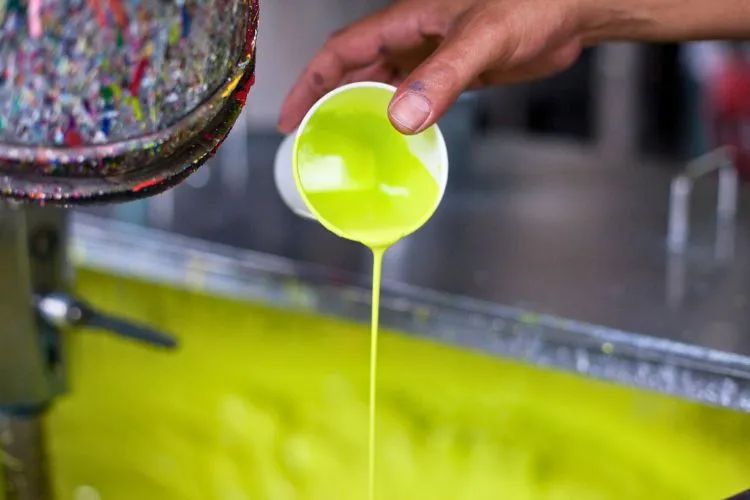Acrylic paint is a staple in the world of art and DIY projects. Known for its versatility, it is often the go-to choice for artists and hobbyists. However, with its wide use comes a necessary concern for safety.
This article delves into the question: “Is acrylic paint carcinogenic?” It aims to explore the composition of acrylic paint and the potential health risks it may pose.

Understanding Acrylic Paint
Acrylic paint is a fast-drying paint made of pigment suspended in an acrylic polymer emulsion. Artists favor it for its ease of use and the vibrant colors it produces. But to understand its safety, we must examine its components.
Definition and Components
Acrylic paint is more than just color. It consists of pigments that provide color, an emulsion that binds the pigments, and several additives to enhance properties like drying time and viscosity.
Types of Acrylic Paint
Acrylic paints come in various forms. Professional paints have more pigments and fewer fillers, resulting in richer color and better blending.
Conversely, student-grade paints are more affordable but have less pigment. The paint’s consistency also differs, with options ranging from fluid to heavy body, each serving different artistic needs.
Health Concerns Associated with Acrylic Paint
When working with acrylic paints, it’s important to know the health risks. The concern for carcinogenicity is mainly due to the chemicals within.

Exposure to Chemicals
Some chemicals in acrylic paint can be harmful. Formaldehyde is sometimes used as a preservative in paint. It’s known for its potential health risks.
Ammonia can be found in paint as well, and heavy metals like cadmium and cobalt are used in pigments. Each of these has known health impacts when exposure occurs through the skin, lungs, or mouth.
Potential Risks
The main health concerns with these chemicals include respiratory problems, skin irritation, and potential links to cancer. For instance, prolonged exposure to formaldehyde can contribute to a higher risk of certain cancers, as categorized by health organizations.
Is Acrylic Paint Carcinogenic?
To determine if acrylic paint is carcinogenic, we must look at the scientific data.
Scientific Evidence
Studies that investigate the components of acrylic paint suggest that some ingredients may have carcinogenic effects. However, the risk often depends on the level and duration of exposure.
Regulatory Perspectives
Organizations like the EPA and OSHA have regulations to limit exposure to harmful chemicals. These guidelines are essential to help protect consumers and workers from potential health risks associated with chemical exposure.
Safe Usage of Acrylic Paint
Awareness and precaution are vital when using acrylic paints.
Best Practices
To minimize risk, use acrylic paints in a well-ventilated area. Wear protective gear, such as gloves and masks, to reduce direct contact and inhalation of paint fumes. Storing paint properly and disposing of it responsibly are equally important.
Alternatives
Manufacturers offer safer alternatives to traditional acrylic paints. These include water-based and non-toxic variations that minimize exposure to hazardous chemicals.
Pro Tips
Check for safety data sheets on your acrylic paint products to understand the potential hazards. If in doubt, reach out to knowledgeable artists or health professionals who can offer advice tailored to your usage patterns.
You may also find useful: Is Acrylic Paint Lead Free? Understanding Lead-Free Options
Acrylic Paint and Environmental Concerns
Acrylic paints, while popular for their versatility and durability, raise environmental concerns due to their composition and disposal. Being petroleum-derived, their production is energy-intensive and contributes to greenhouse gas emissions.
Once acrylics dry, they become a plastic polymer, making them difficult to break down, thus contributing to plastic pollution. Their disposal poses a significant challenge, as improper handling can lead to toxic substances leaching into soil and waterways, affecting aquatic life and ecosystems.

To mitigate these impacts, artists and manufacturers are exploring eco-friendly alternatives and practices. Water-based acrylics, which have lower volatile organic compound (VOC) emissions, are a step toward sustainability.
Additionally, some companies are developing biodegradable paints or those made from natural dyes and binders. Artists can also adopt practices such as minimizing paint waste, using recyclable or reusable containers, and properly disposing of paint waste according to local environmental regulations.
By opting for more sustainable practices and materials, the art community can significantly reduce the environmental footprint of acrylic painting.
Reviewing Case Studies
Documented case studies focused on health concerns arising from exposure to acrylic paint components have underscored the importance of understanding and mitigating potential risks.
For instance, studies highlighting the adverse effects of inhaling volatile organic compounds (VOCs) and heavy metals like cadmium and cobalt, commonly found in certain pigments, have led to increased scrutiny of paint formulations.
Occupational exposure cases, particularly among artists and factory workers, have been instrumental in pushing for safer paint formulations. These cases catalyzed the development and adoption of low-VOC and non-toxic acrylic paints.
Moreover, the acknowledgment of allergic reactions and respiratory issues in some individuals has prompted manufacturers to clearly label their products for hazards, thereby empowering users to make informed choices.
These case studies collectively emphasize the evolving nature of paint safety protocols and the art industry’s response in prioritizing health while maintaining artistic integrity.
Frequently Asked Questions (FAQs)
Can using acrylic paint cause cancer?
The possibility exists if the paint contains carcinogenic chemicals and the exposure is significant. Always check the components and use paints safely.
What safety measures can I take when working with acrylic paint?
Use the paints in ventilated spaces, wear protective gear, and follow safe storage and disposal practices.
Are there any non-toxic alternatives to traditional acrylic paints?
Yes, some acrylic paints are labeled as non-toxic. Look for these options if you have concerns about toxicity.
How can I dispose of acrylic paint safely?
Local waste management guidelines will provide the best practices for disposing of acrylic paint in your area.
Do professional-grade acrylic paints pose a greater risk than student-grade ones?
Professional-grade paints may contain a higher concentration of pigments, some of which may have more risk associated with them. It’s essential to check the labels carefully.
Conclusion:
In conclusion, while certain components within acrylic paint may pose health risks, being well-informed and practicing safe usage can greatly reduce these concerns.
It is important to stay informed about the materials you use, especially if they are part of your daily routine.

Meet Isabella Anderson, your acrylic painting mentor with over a decade of brush-wielding mastery. Dive into the colorful world of acrylics with her expert guidance, featured exclusively on ‘Acrylic Authority.’ Unleash your inner artist and explore the limitless possibilities of this versatile medium alongside a true acrylic aficionado.
